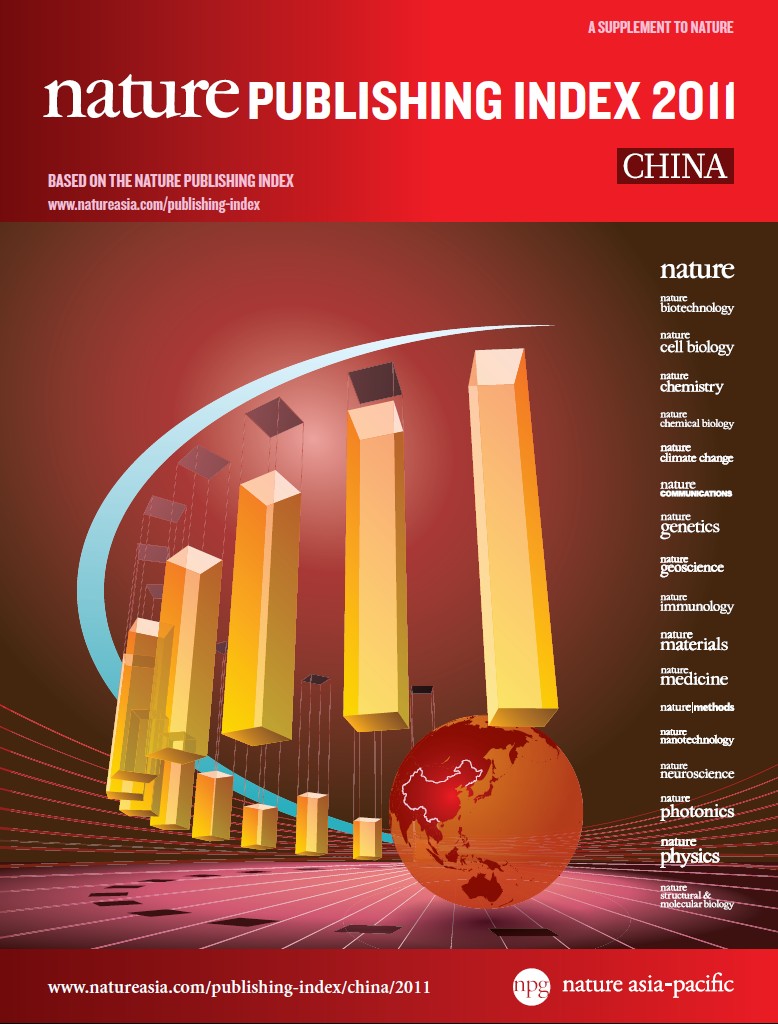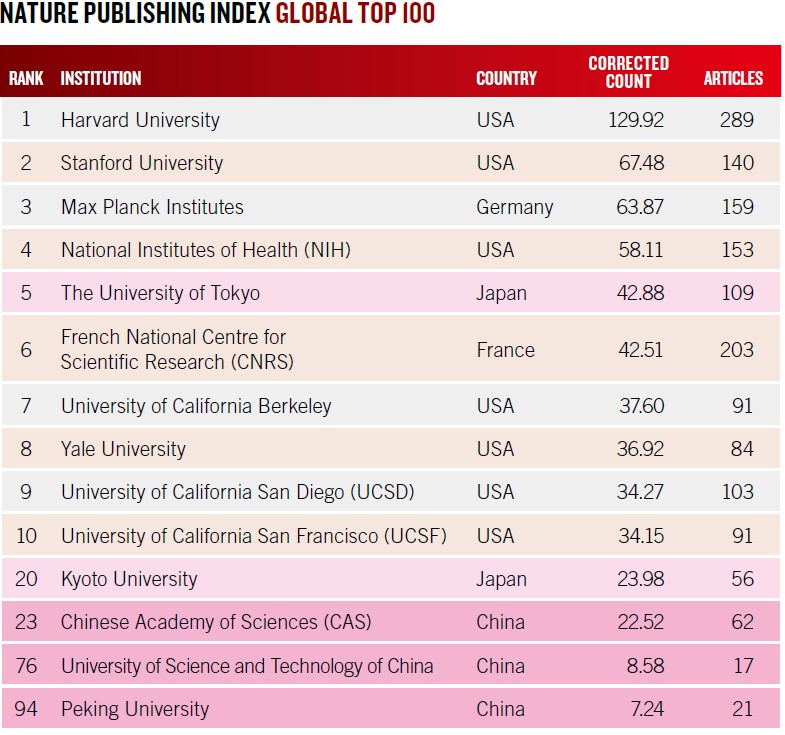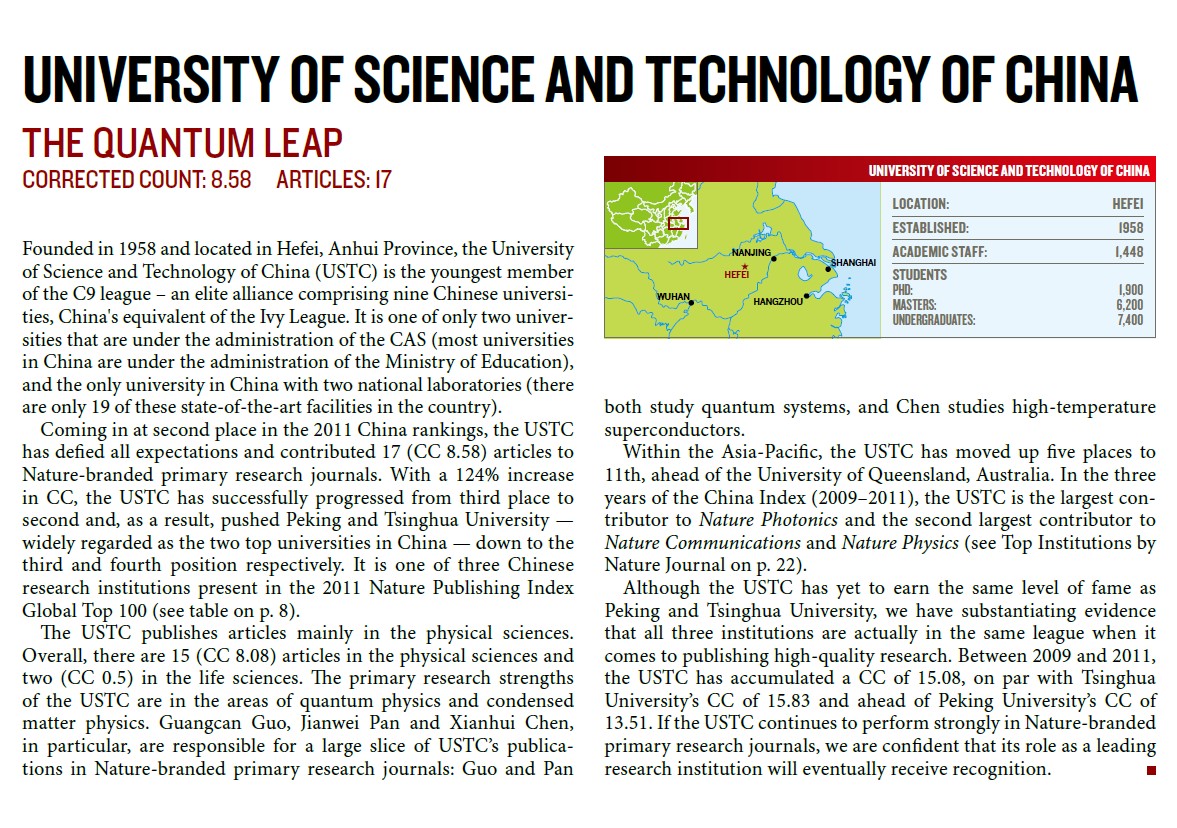(Nature给了武书连一记响亮的世界级耳光)
http://www.ustcif.org/default.php/content/1359/
5月24日,英国《自然》杂志发布名为《自然出版指数中国2011》(Nature Publishing Index 2011 China)的报告。报告指出,中国目前在《自然》系列期刊上发表论文的比率已经超过6%。报告更提供了大量数据,表明中国在发表论文和科学研究两方面快将成为全球的领导者。该报告更盛赞中国科大虽在深闺,不为民众所知,但以科研实力论,堪称中国翘楚。

《自然出版指数中国2011》封面。点击下载该报告: http://www.ustcif.org/global/fil ... 2012/Nature2011.PDF
该报告指出,2011年全球在《自然》系列期刊上发表论文的总量为3,425篇,中国在《自然》系列期刊上发表论文的数量为225篇(比率为6.6%),相比2010年的152篇(比率为5.3%),有明显的增长。与2000年的12篇相比,更是不可同日而语。值得关注的是,在2011年发表的225篇论文中,有48篇论文是发表在2010年4月推出的《自然通讯》(Nature Communications)上。
《自然出版指数2011-中国》还利用ISI数据作出了新的分析,发现在全球最有影响力的论文中,也就是引用率最高的1%的论文当中,超过10%是由中国科学家发表的。比率从2001年的1.85%(在6,874篇最有影响力的论文当中占127篇)增加到2011年的11.3%(在10,238篇最有影响力的论文当中占1,158篇),名列全球第四。负责撰写《自然出版指数2011-中国》报告和身兼《自然中国》主编的张文浩博士说,美国在发表全球最有影响力的论文方面,比率从2001年的64.3%(在6,874篇最有影响力的论文当中占4,420篇)下降到2011年的50.7%(在10,238篇最有影响力的论文当中占5,190篇)。张博士预计,中国将在2014年超越目前排第二的德国和排第三的英国,成为继美国之后全球最有影响力的科技强国。

《自然出版指数中国2011》报告以表格强调,中国科学院(#23)、中国科学技术大学(#76)与北京大学(#94)是中国仅有的三家杀进全球顶尖一百科研机构。中国科大领先其对手北京大学。中国科大仅落后于其东家中国科学院,而后者拥100所研究所和接近50,000名研究人员。
《自然出版指数2011中国》对科研经费、科研机构和城市如何促进了中国科研的急剧发展提供了深入的见解。报告列出了2011年中国十大科研机构的排名:中国科学院、中国科学技术大学、北京大学、清华大学、香港科技大学、厦门大学、上海交通大学、香港大学、南京大学和深圳华大基因。
中国科学院遥遥领先,总共在《自然》系列期刊上发表了62篇论文。这个不难理解,因为中国科学院拥有超过100所研究所和接近50,000名研究人员。该报告特别指出,在芸芸大学中,中国科学技术大学排名第一。 张文浩指出,民众通常认为北大和清华是中国高校的双巨头。中国科大虽不坐拥和北大或清华同样的名气,但以发表高质量的科研论文的实力论,实情是中国科大和清华北大三强鼎立,不分伯仲。
《自然出版指数2011中国》也提供了城市的排名。在发表高质量的科研论文方面,2011年中国十大城市依次是北京、上海、合肥、香港、南京、武汉、厦门、杭州、深圳和西安。这十个科研城市在《自然》系列期刊上发表论文的总量约占全国86%,并拥有2011年二十大科研机构中的19所。
《自然出版指数2011-中国》以《自然》系列期刊在2011年所发表的论文为基础,衡量不同国家和研究机构的科研实力,并对2010年和2009年的数据进行比较。 张博士指出,自然出版指数分析了科研机构和他们所在的城市,并为评估科研质量提供了新的渠道。
今天发布的《自然出版指数2011中国》报告可点击这里 下载。排名是根据在2011年发表的论文为基础,并提供2010年、2009年和三年(从2009到2011年)数据进行比较。该指数每周更新一次,详情请浏览点击这里。 《自然》报告专文盛赞中国科大:

《自然》撰专文盛赞中国科大,历数她特色鲜明。介绍中国科大属中国科学院(而不像多数高校那样隶属教育部),拥有两个国家实验室(中国高校仅此一家)。 报告介绍,2011年中国科大成功的从第三进步为第二。结果是:将北京大学与清华大学挤到第三、第四——虽然后两所大学通常被认为是中国双子星。
报告称,中国科大虽不坐拥和北大或清华同样的名气,“我们有充足的证据显示”,但以发表高质量的科研论文的实力论,实情是中国科大和清华北大三强鼎力,不分伯仲。如果中国科大能延续在自然系列杂志发表的强劲势头,“我们坚信”,中国科大作为顶尖研究型大学的地位终将赢得承认。

《自然》报告也介绍合肥,评价以人口、GDP而论,合肥恐怕只是二线城市,但以研发实力论英雄,合肥堪称一等一(first tier city)。该报告更称,以科研实力排座次,合肥已然超越香港(与南京)。该报告介绍合肥时不惜篇幅再次介绍中国科大,也指出安徽医科大学、安徽农业大学与安徽大学进入中国百强。其中安徽医科大学是中国皮肤病研究的顶尖大学,过去三年安徽医科大学是Nature Genetics的论文中国最大贡献者。
英国自然出版集团相关报道(英文)
China on track for #2 most influential country in science publishing by 2014
China now publishes more than 6% of the papers published in Nature journals, according to the Nature Publishing Index 2011 China. Published today as a supplement to Nature, the Index provides yet more evidence that China is fast becoming a global leader in scientific publishing and scientific research.
Papers with authors from China represent 6.6% (225) of the 3425 papers published in Nature journals in 2011, up from 5.3% (152 papers) in 2010. By comparison, authors from China published just 12 papers in Nature journals in 2000. Notably, of the 225 papers published in 2011, 48 were published in Nature Communications which launched in April 2010.
The Nature Publishing Index 2011 China also presents a new analysis of ISI Web of Knowledge data, showing that China now publishes more than 10% of the world’s most cited scientific research. China increased its share of the top 1% of highly cited scientific articles from 1.85% (127 out of 6,874 articles) in 2001 to 11.3% (1,158 out of 10,238 articles) in 2011, and now ranks fourth globally. By 2014, China could surpass Germany and the United Kingdom, who currently hold second and third places, says Felix Cheung, Editor of Nature China and of the supplement. The United States, which leads the world, has seen its share of highly influential research drop from 64.3% (4,420 out of 6,874 articles) in 2001 to 50.7% (5,190 out of 10,238 articles) in 2011.
The supplement offers insights into how national investments, institutions and cities have contributed to China’s rapid scientific expansion.
The top ten Chinese institutions of 2011 are: the Chinese Academy of Sciences (CAS), the University of Science and Technology of China (USTC), Peking University, Tsinghua University, Hong Kong University of Science and Technology (HKUST), Xiamen University, Shanghai Jiao Tong University (SJTU), the University of Hong Kong (HKU), Nanjing University and BGI Shenzhen.
CAS has an impressive lead, publishing 62 articles in Nature-branded primary research journals in 2011, which is perhaps not surprising given it has over 100 institutes and close to 50,000 researchers. Among the universities, USTC came out number one. “People generally consider Peking and Tsinghua University as the ‘big two’ in China,” says Cheung. “Although the USTC has yet to earn the same level of fame as Peking and Tsinghua University, the reality is that all three institutions are in the same league when it comes to publishing high-quality research.”
The Nature Publishing Index 2011 China supplement also presents a ranking by city. The top ten Chinese cities of 2011 for high-quality basic research are: Beijing, Shanghai, Hefei, Hong Kong, Nanjing, Wuhan, Xiamen, Hangzhou, Shenzhen and Xi’an. These ten cities account for approximately 86% of China’s contribution to Nature-branded primary research journals in 2011, and also house 19 of the top 20 institutions in the China rankings.
The Index measures the output of research articles from nations and institutes in terms of publications in the 18 Nature-branded primary research journals in 2011, with 2010 and 2009 data included for comparison. “The Nature Publishing Index offers a unique way to assess the high quality research output of an institution or a city in China,” said Cheung. “We have analysed the index data and assessed the various strengths of each institution and city.”
The Nature Publishing Index 2011 China supplement is available online at here and is published as a supplement to Nature today. The ranking is a snapshot based on papers published in 2011, with 2010, 2009 and three-year total (2009–2011) data included for comparison. The index, updated weekly, is available at here .
2012-05-24




 雷达卡
雷达卡







 京公网安备 11010802022788号
京公网安备 11010802022788号







